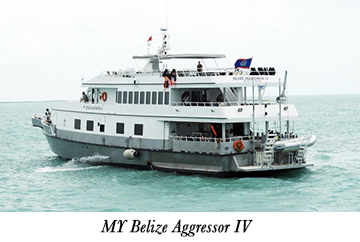Belize Aggressor IV, BelizeContents of this Issue: Panama, Misool, Caye Caulker, Rapa Nui The Tragedy of the Liveaboard Industry The Call for Regulation of Liveaboards Thailand Bans Cameras for New Divers Editorial Office: Ben Davison Publisher and Editor Undercurrent 3020 Bridgeway, Suite 102 Sausalito, CA 94965 as the temperatures rise from the May, 2025 issue of Undercurrent
Subscriber Content Preview Dear Fellow Diver, In late October, I was aboard the roomy Belize Aggressor IV as it departed Belize City on a windy, rainy Saturday evening, sailing past mangrove keys that shield Belize's coast. We 18 divers, from beginners to instructors, organized by our Midwest dive store, had dinner and a quiet evening of socializing over a few drinks. Our time was intertwined with multiple boat briefings identical to those on the Roatan Aggressor, on which I was aboard just a few weeks previous (I reviewed it in the March issue). The crew covered boat policy, dive deck routine, nitrox routine, boat and fire safety, battery charging, diving routine (no decompression diving), and boat safety recall, and introduced the dedicated night watchman. I'm sure they presented everything their lawyers and risk managers wanted, a bit too much to digest for these tired travelers.
In Honduras, we traveled about 100 miles south, off the beaten path, where the Roatan Aggressor visits healthy reefs with plenty of fish. Having been to Belize several times, I knew there was good diving, though the summer of 2024 brought hot weather and unusually warm waters. As I dozed off, I dreamed of a bright morning with clear blue skies, sunlight piercing the ocean's surface, and vibrant reefs. It wouldn't happen. Our captain, Dennis Gautau, a good old Cajun boy, motored out 55 miles to moor for an early morning dive in the marine park at Half Moon Caye in the Lighthouse Reef system. Grumbling about the overcast day, I had a coffee and bagel during our thorough dive briefing and soon stepped off the huge dive platform into the choppy 87-degree water with 100-foot visibility. First in the water, my buddy and I followed the mooring line down 60 feet to an enormous sand patch that gradually slopes to 70 feet and a coral ridge before the wall drops into the abyss. While waiting for others, I caught something at the edge of visibility. A big eagle ray -- maybe eight feet across -- gradually flapped within 15 feet of me. After making two lazy passes, it eased back into the blue. That's why I always do my darndest to be the first diver in the water, especially in the morning.... Subscribers: Read the full article here ; |

I want to get all the stories! Tell me how I can become an Undercurrent Online Member and get online access to all the articles of Undercurrent as well as thousands of first hand reports on dive operations world-wide
| Home | Online Members Area | My Account |
Login
|
Join
|
| Travel Index |
Dive Resort & Liveaboard Reviews
|
Featured Reports
|
Recent
Issues
|
Back Issues
|
|
Dive Gear
Index
|
Health/Safety Index
|
Environment & Misc.
Index
|
Seasonal Planner
|
Blogs
|
Free Articles
|
Book Picks
|
News
|
|
Special Offers
|
RSS
|
FAQ
|
About Us
|
Contact Us
|
Links
|
3020 Bridgeway, Ste 102, Sausalito, Ca 94965
All rights reserved.

 I headed down for a good night's sleep in my spacious twin bed in my roomy cabin, a good-sized closet, and a separate head with a full shower, sink, and toilet. AC was perfect; the hot water was unending. Clearly, this was a more comfortable craft than the Roatan Aggressor, but would the diving measure up?
I headed down for a good night's sleep in my spacious twin bed in my roomy cabin, a good-sized closet, and a separate head with a full shower, sink, and toilet. AC was perfect; the hot water was unending. Clearly, this was a more comfortable craft than the Roatan Aggressor, but would the diving measure up?